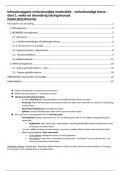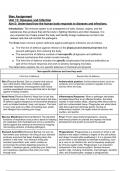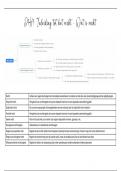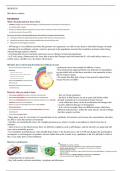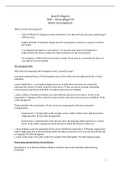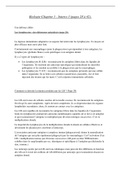Package deal
MIX PAPERS :AQA GCSE REVISIONS QUESTIONS AND ANSWERS
MIX PAPERS :AQA GCSE REVISIONS QUESTIONS AND ANSWERS HIGHLY PASSED
[Show more]MIX PAPERS :AQA GCSE REVISIONS QUESTIONS AND ANSWERS HIGHLY PASSED
[Show more]Ion An atom or group of atoms that has lost or gained electrons and therefore a positive or negative charge. Polyatomic ion An ion that is made of more then one atom Metal ion an atom which has lost electrons forming a positive ion Non-metal ion an atom which has gained electrons forming nega...
Preview 2 out of 6 pages
Add to cartIon An atom or group of atoms that has lost or gained electrons and therefore a positive or negative charge. Polyatomic ion An ion that is made of more then one atom Metal ion an atom which has lost electrons forming a positive ion Non-metal ion an atom which has gained electrons forming nega...
Transition elements are found In the middle block of the periodic tableRe Physical properties of transition elements Hard, high melthing points, strong and dense. Chemical properties of transition elements Slow/no reaction with oxygen, water and halogens Charges on transition metal ions Form ...
Preview 1 out of 3 pages
Add to cartTransition elements are found In the middle block of the periodic tableRe Physical properties of transition elements Hard, high melthing points, strong and dense. Chemical properties of transition elements Slow/no reaction with oxygen, water and halogens Charges on transition metal ions Form ...
Mixture A combination of two or more substances that are not chemically joined. Filtration Separates insoluble solids from liquids. Crystallisation The formation of crystals by cooling a saturated solution Simple distillation Used to separate a liquid from a solution
Preview 2 out of 10 pages
Add to cartMixture A combination of two or more substances that are not chemically joined. Filtration Separates insoluble solids from liquids. Crystallisation The formation of crystals by cooling a saturated solution Simple distillation Used to separate a liquid from a solution
Requirements for a reaction to take place Particles must collide, with sufficient energy Activation energy Minimum amount of energy required to start a chemical reaction Reaction profile diagram A graph which shows the change in energy of a chemical reaction Products The new substances formed...
Preview 2 out of 5 pages
Add to cartRequirements for a reaction to take place Particles must collide, with sufficient energy Activation energy Minimum amount of energy required to start a chemical reaction Reaction profile diagram A graph which shows the change in energy of a chemical reaction Products The new substances formed...
H - Hydrogen He - Helium Fe - Iron N - Nitrogen Na - Sodium F - Fluorine Li - Lithium C - Carbon CO2 - carbon dioxide
Preview 1 out of 2 pages
Add to cartH - Hydrogen He - Helium Fe - Iron N - Nitrogen Na - Sodium F - Fluorine Li - Lithium C - Carbon CO2 - carbon dioxide
Metal An element that forms positive ions pH of metal oxide Basic Non-metal Does not form positive ions pH of non-metal oxide Acidic Reduction in terms of oxygen Loss of oxygen Oxidation in terms of oxygen Gain of oxygen Oxidation in terms of electrons Loss of electrons
Preview 2 out of 8 pages
Add to cartMetal An element that forms positive ions pH of metal oxide Basic Non-metal Does not form positive ions pH of non-metal oxide Acidic Reduction in terms of oxygen Loss of oxygen Oxidation in terms of oxygen Gain of oxygen Oxidation in terms of electrons Loss of electrons
Metals Elements which form positive ions Non-metals Elements which do not form positive ions Metals position on periodic table on the left hand side Non-metals position on periodic table
Preview 2 out of 8 pages
Add to cartMetals Elements which form positive ions Non-metals Elements which do not form positive ions Metals position on periodic table on the left hand side Non-metals position on periodic table
Formation of metal ions Atoms lose outer electrons Metals Elements that form positive ions Formation of non-metal ions Atoms gain electrons Charge on non-metal ions negative Group 1 ions charge +1 Group 2 ions charge +2 Group 6 ions charge -2 Group 7 ions charge
Preview 2 out of 7 pages
Add to cartFormation of metal ions Atoms lose outer electrons Metals Elements that form positive ions Formation of non-metal ions Atoms gain electrons Charge on non-metal ions negative Group 1 ions charge +1 Group 2 ions charge +2 Group 6 ions charge -2 Group 7 ions charge
Name of Group 7 elements The halogens Group 7 elements have similar chemical properties because they all have 7 outer shell electrons Diatomic molecule A molecule consisting of two atoms
Preview 1 out of 4 pages
Add to cartName of Group 7 elements The halogens Group 7 elements have similar chemical properties because they all have 7 outer shell electrons Diatomic molecule A molecule consisting of two atoms
Natural Hazard - A natural hazard is a natural process which could cause death, injury or disruption to humans, or destroy proprty or posesions. Natural disaster - A natural hzard that has actualy happened Geological hazards - Caused by kand and tectonic processes Meteorological hazards - Caused...
Preview 2 out of 14 pages
Add to cartNatural Hazard - A natural hazard is a natural process which could cause death, injury or disruption to humans, or destroy proprty or posesions. Natural disaster - A natural hzard that has actualy happened Geological hazards - Caused by kand and tectonic processes Meteorological hazards - Caused...
Tough supporting wall of the eye - Sclera Transparent outer layer found at the front of the eye. Refracts (bends) light into the eye - Cornea Contains muscles that allow it to control the diameter of the Pupil (hole in the middle) and therefore how much light enters the eye - Iris Focuses light ...
Preview 1 out of 2 pages
Add to cartTough supporting wall of the eye - Sclera Transparent outer layer found at the front of the eye. Refracts (bends) light into the eye - Cornea Contains muscles that allow it to control the diameter of the Pupil (hole in the middle) and therefore how much light enters the eye - Iris Focuses light ...
What are the structures of an animal cell? - Nucleus, cytoplasm, cell membrane, mitochondria and ribosomes. What are the structures of a plant cell? - All structures from animal cells and cell wall, permanent vacuole and chloroplasts. What does the nucleus do? - Stores DNA and directs all cellul...
Preview 2 out of 15 pages
Add to cartWhat are the structures of an animal cell? - Nucleus, cytoplasm, cell membrane, mitochondria and ribosomes. What are the structures of a plant cell? - All structures from animal cells and cell wall, permanent vacuole and chloroplasts. What does the nucleus do? - Stores DNA and directs all cellul...
What are the structures of an animal cell? - Nucleus, cytoplasm, cell membrane, mitochondria and ribosomes. What are the structures of a plant cell? - All structures from animal cells and cell wall, permanent vacuole and chloroplasts. What does the nucleus do? - Stores DNA and directs all cellul...
Preview 2 out of 15 pages
Add to cartWhat are the structures of an animal cell? - Nucleus, cytoplasm, cell membrane, mitochondria and ribosomes. What are the structures of a plant cell? - All structures from animal cells and cell wall, permanent vacuole and chloroplasts. What does the nucleus do? - Stores DNA and directs all cellul...
Atom Smallest part of an element Element A pure substance made of only one kind of atom Compound A substance made up of atoms of two or more different elements joined by chemical bonds Mixture A combination of two or more different substances that are not joined by chemical bonds
Preview 2 out of 5 pages
Add to cartAtom Smallest part of an element Element A pure substance made of only one kind of atom Compound A substance made up of atoms of two or more different elements joined by chemical bonds Mixture A combination of two or more different substances that are not joined by chemical bonds
First shell can hold 2 electrons 2nd and 3rd shell can hold 8 electrons no of shells = Period on the periodic table Valence electrons Outer shell electrons which are involved in reactions No of valence electrons = Group number on the periodic table Hydrogen electron structure 1 Nitrogen ...
Preview 1 out of 3 pages
Add to cartFirst shell can hold 2 electrons 2nd and 3rd shell can hold 8 electrons no of shells = Period on the periodic table Valence electrons Outer shell electrons which are involved in reactions No of valence electrons = Group number on the periodic table Hydrogen electron structure 1 Nitrogen ...
What are 'Mechanical Properties'? - Properties of materials, including strength, hardness, density, durability, toughness, malleability, elasticity and ductility What is 'bending'? - The ability to withstand forces that are attempting to bend What is 'compression'? - The resistance to force...
Preview 1 out of 2 pages
Add to cartWhat are 'Mechanical Properties'? - Properties of materials, including strength, hardness, density, durability, toughness, malleability, elasticity and ductility What is 'bending'? - The ability to withstand forces that are attempting to bend What is 'compression'? - The resistance to force...
Ancient greek model of the atom Atoms are tiny solid spheres which cannot be divided. JJ Thompson Discovered the electron and developed the "plum-pudding" model of the atom plum pudding model of the atom atoms are balls of positively charge with negative electrons embedded in it
Preview 2 out of 7 pages
Add to cartAncient greek model of the atom Atoms are tiny solid spheres which cannot be divided. JJ Thompson Discovered the electron and developed the "plum-pudding" model of the atom plum pudding model of the atom atoms are balls of positively charge with negative electrons embedded in it
Relative mass of a proton 1 . Relative mass of a neutron about the same as that of a proton Relative mass of an electron 1/1840 Relative charge of a proton +1 Relative charge of a neutron 0 Relative charge of an electron -1 Neutral atoms same number of positive protons as negative elec...
Preview 2 out of 6 pages
Add to cartRelative mass of a proton 1 . Relative mass of a neutron about the same as that of a proton Relative mass of an electron 1/1840 Relative charge of a proton +1 Relative charge of a neutron 0 Relative charge of an electron -1 Neutral atoms same number of positive protons as negative elec...
Relative mass of a proton 1 Relative mass of a neutron about the same as that of a proton Relative mass of an electron 1/1840 Relative charge of a proton +1 Relative charge of a neutron 0 Relative charge of an electron -1 Neutral atoms same number of positive protons as negative electro...
Preview 2 out of 7 pages
Add to cartRelative mass of a proton 1 Relative mass of a neutron about the same as that of a proton Relative mass of an electron 1/1840 Relative charge of a proton +1 Relative charge of a neutron 0 Relative charge of an electron -1 Neutral atoms same number of positive protons as negative electro...
What are eukaryotic cells? - Cells that are more complex and have a nucleus (animal and plant cells) What are prokaryotic cells? - Cells that are smaller and simpler, and don't have a nucleus but still have genetic information (bacteria) What are eukaryotes? - Organisms made of eukaryotic cells ...
Preview 4 out of 48 pages
Add to cartWhat are eukaryotic cells? - Cells that are more complex and have a nucleus (animal and plant cells) What are prokaryotic cells? - Cells that are smaller and simpler, and don't have a nucleus but still have genetic information (bacteria) What are eukaryotes? - Organisms made of eukaryotic cells ...
Energy Stores - 1) Elastic potential 2) Gravitational potential 3) Thermal 4) Electrostatic 5) Nuclear 6) Chemical 7) Kinetic 8) Magnetic 9) Light 10) Sound How is energy transferred? - 1) Mechanically - force doing work 2) Electrically - work done by moving charges 3) Heating/Radiation ...
Preview 4 out of 31 pages
Add to cartEnergy Stores - 1) Elastic potential 2) Gravitational potential 3) Thermal 4) Electrostatic 5) Nuclear 6) Chemical 7) Kinetic 8) Magnetic 9) Light 10) Sound How is energy transferred? - 1) Mechanically - force doing work 2) Electrically - work done by moving charges 3) Heating/Radiation ...
Weight - Mass x Gravitational Field Strength Work Done - Force x Distance Force Applied to a Spring - Spring Constant x Extension Moment of a Force - Force x Distance Pressure - Force / Area
Preview 1 out of 4 pages
Add to cartWeight - Mass x Gravitational Field Strength Work Done - Force x Distance Force Applied to a Spring - Spring Constant x Extension Moment of a Force - Force x Distance Pressure - Force / Area
This type of surface is a good absorber and emitter of thermal radiation - Dark, rough (matt) surface This type of surface is a bad absorber and emitter of thermal radiation - Light, shiny surface In this process particles vibrate colliding with each other passing energy along. Solids are best at...
Preview 2 out of 5 pages
Add to cartThis type of surface is a good absorber and emitter of thermal radiation - Dark, rough (matt) surface This type of surface is a bad absorber and emitter of thermal radiation - Light, shiny surface In this process particles vibrate colliding with each other passing energy along. Solids are best at...
What is the charge of a proton? - +1 What is the charge of a neutron? - 0 What is the charge of an electron? - -1 What is the relative mass of a proton? - 1 What is the relative mass of a neutron? - 1 What is the relative mass of an electron? - Very small How many types of atoms do elements co...
Preview 3 out of 29 pages
Add to cartWhat is the charge of a proton? - +1 What is the charge of a neutron? - 0 What is the charge of an electron? - -1 What is the relative mass of a proton? - 1 What is the relative mass of a neutron? - 1 What is the relative mass of an electron? - Very small How many types of atoms do elements co...
What does a nucleus do? - It contains genetic material and controls the activities of the cell What does cytoplasm do? - It's a gel-like substance where most of the chemical reactions happen. It contains enzymes that control these chemical reactions What does a cell membrane do? - It holds the c...
Preview 4 out of 37 pages
Add to cartWhat does a nucleus do? - It contains genetic material and controls the activities of the cell What does cytoplasm do? - It's a gel-like substance where most of the chemical reactions happen. It contains enzymes that control these chemical reactions What does a cell membrane do? - It holds the c...
What is homeostasis? - The maintenance of a constant internal environment. What is a stimulus? - A change in your environment than requires a response. e.g Light, sound, touch, pressure, pain, chemical or temperature. What do the receptors do? - Detect the stimulus or change in environment. What...
Preview 4 out of 37 pages
Add to cartWhat is homeostasis? - The maintenance of a constant internal environment. What is a stimulus? - A change in your environment than requires a response. e.g Light, sound, touch, pressure, pain, chemical or temperature. What do the receptors do? - Detect the stimulus or change in environment. What...
How is the real size of a magnified image calculated? - Real size = Image size ÷ Total magnification. What is a eukaryotic cell? - A cell with DNA inside a membrane bound nucleus. Prokaryotic cells do not have a nucleus. Name two differences between a plant cell and a bacterial cell? - Plant ce...
Preview 1 out of 3 pages
Add to cartHow is the real size of a magnified image calculated? - Real size = Image size ÷ Total magnification. What is a eukaryotic cell? - A cell with DNA inside a membrane bound nucleus. Prokaryotic cells do not have a nucleus. Name two differences between a plant cell and a bacterial cell? - Plant ce...
How is the real size of a magnified image calculated? - Real size = Image size ÷ Total magnification. What is a eukaryotic cell? - A cell with DNA inside a membrane bound nucleus. Prokaryotic cells do not have a nucleus. Name two differences between a plant cell and a bacterial cell? - Plant ce...
Preview 1 out of 3 pages
Add to cartHow is the real size of a magnified image calculated? - Real size = Image size ÷ Total magnification. What is a eukaryotic cell? - A cell with DNA inside a membrane bound nucleus. Prokaryotic cells do not have a nucleus. Name two differences between a plant cell and a bacterial cell? - Plant ce...
What are cells? - The building blocks of organisms Define eukaryotic cell - Cells that have a true nucleus Define prokaryotic cell - Cells that do not have a true nucleus What is in an animal cell? - Nucleus, cytoplasm, cell membrane, mitochondria, ribosomes What is in a plant cell? - Same as an...
Preview 2 out of 6 pages
Add to cartWhat are cells? - The building blocks of organisms Define eukaryotic cell - Cells that have a true nucleus Define prokaryotic cell - Cells that do not have a true nucleus What is in an animal cell? - Nucleus, cytoplasm, cell membrane, mitochondria, ribosomes What is in a plant cell? - Same as an...
Buffer stock - A stock of raw materials held in reserve to protect the production process from unforeseen shortages. Customer loyalty - The likelihood that past customers will continue to buy from the business, enhanced by high quality customer service and/or reward programmes. Customer satisfac...
Preview 2 out of 5 pages
Add to cartBuffer stock - A stock of raw materials held in reserve to protect the production process from unforeseen shortages. Customer loyalty - The likelihood that past customers will continue to buy from the business, enhanced by high quality customer service and/or reward programmes. Customer satisfac...
describe and explain the steps in the light dependent reaction of photosynthesis - 1. photoionisation: light reaches chlorophyll in PSII, which is absorbed by an electron, which becomes excited and moves to a higher energy level. 2. the electron passes to a carrier protein in the thylakoid membra...
Preview 3 out of 20 pages
Add to cartdescribe and explain the steps in the light dependent reaction of photosynthesis - 1. photoionisation: light reaches chlorophyll in PSII, which is absorbed by an electron, which becomes excited and moves to a higher energy level. 2. the electron passes to a carrier protein in the thylakoid membra...
large molecules often contain carbon. why? - they can readily form bonds with other carbon atoms. this forms a 'backbone'. other atoms can then attach. describe benedicts test for reducing sugars - add equal volumes of the sugar sample and benedicts reagent. heat the mixture in a water bath fo...
Preview 3 out of 23 pages
Add to cartlarge molecules often contain carbon. why? - they can readily form bonds with other carbon atoms. this forms a 'backbone'. other atoms can then attach. describe benedicts test for reducing sugars - add equal volumes of the sugar sample and benedicts reagent. heat the mixture in a water bath fo...
Describe how you would use a biochemical test to show that a solution contained a non-reducing sugar, such as sucrose. [3] - ,first reducing sugars test; boil with dilute HCl acid then Neutralise with NaHCǑ, add benedict and heat to 95 degrees C brick red ppt forms if reducing sugar is present D...
Preview 4 out of 82 pages
Add to cartDescribe how you would use a biochemical test to show that a solution contained a non-reducing sugar, such as sucrose. [3] - ,first reducing sugars test; boil with dilute HCl acid then Neutralise with NaHCǑ, add benedict and heat to 95 degrees C brick red ppt forms if reducing sugar is present D...
What are chromosomes? - They are really long molecules of DNA What does DNA stand for - DeoxyribonNucleicAcid. It is a complex chemical in a thread-like chain. It contains coded information and genetic information Where is DNA found - It is found in the nucleus of animal and plant cells in long s...
Preview 2 out of 13 pages
Add to cartWhat are chromosomes? - They are really long molecules of DNA What does DNA stand for - DeoxyribonNucleicAcid. It is a complex chemical in a thread-like chain. It contains coded information and genetic information Where is DNA found - It is found in the nucleus of animal and plant cells in long s...
What are the two types of microscopes? - Light Microscope Electron Microscope What is the magnifying power of a light microscope? - x 2,000 What is the magnifying power of an electron microscope? - x 2,000,000 What is the resolving power? - The ability to distinguish between two separate points ...
Preview 4 out of 35 pages
Add to cartWhat are the two types of microscopes? - Light Microscope Electron Microscope What is the magnifying power of a light microscope? - x 2,000 What is the magnifying power of an electron microscope? - x 2,000,000 What is the resolving power? - The ability to distinguish between two separate points ...
Ecosystem - The interaction of a community of living organisms with the non-living parts of their environment What is a community made up of? - The populations of different species or organisms that are all interdependent in a habitat Habitat - The environment in which an organism lives Populat...
Preview 2 out of 15 pages
Add to cartEcosystem - The interaction of a community of living organisms with the non-living parts of their environment What is a community made up of? - The populations of different species or organisms that are all interdependent in a habitat Habitat - The environment in which an organism lives Populat...

Stuvia customers have reviewed more than 700,000 summaries. This how you know that you are buying the best documents.

You can quickly pay through credit card for the summaries. There is no membership needed.

Your fellow students write the study notes themselves, which is why the documents are always reliable and up-to-date. This ensures you quickly get to the core!
You get a PDF, available immediately after your purchase. The purchased document is accessible anytime, anywhere and indefinitely through your profile.
Our satisfaction guarantee ensures that you always find a study document that suits you well. You fill out a form, and our customer service team takes care of the rest.
Stuvia is a marketplace, so you are not buying this document from us, but from seller jessyqueen. Stuvia facilitates payment to the seller.
No, you only buy these notes for £70.49. You're not tied to anything after your purchase.
4.6 stars on Google & Trustpilot (+1000 reviews)
71851 documents were sold in the last 30 days
Founded in 2010, the go-to place to buy revision notes and other study material for 15 years now
